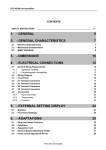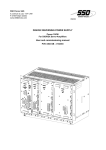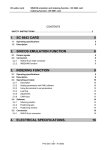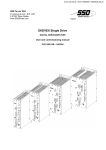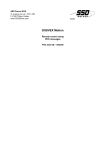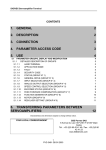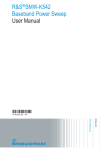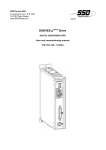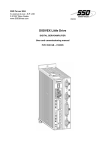Download 1. PANNEAU DE COMMANDE PARVEX
Transcript
DIGIVEX - "SSI" ABSOLUTE ENCODING CONTENTS SAFETY INSTRUCTIONS ……………………………………………………………………………2 1. GENERAL 4 2. OPERATION 4 2.1 TYPE OF POSITION SIGNAL 2.2 SIGNAL CHARACTERISTICS 2.2.1 Transmission speed 2.2.2 Signal level 2.3 MEMORIZATION OF THE "POSITION FAULT" DIAGNOSIS SIGNAL POSITION 2.4 SOFT LIMIT - ORIGIN DEFINED BY LOGIC INPUTS 2.4.1 Origin setting defined 2.4.2 Software LIMITS 3. PARAMETER INPUT 9 3.1 VIA DIGIVEX-PC SOFTWARE 3.1.1 SOFTWARE DESCRIPTION 3.1.1.1 Travail "OFF LINE" 3.1.1.2 Working "ON-LINE" 3.2 VIA DTP001 CONSOLE 3.3 PARAMETER FUNCTIONS AND VALUES 4. CONNECTIONS / STRAP POSITIONS 4.1 4.2 4.3 4.4 4 5 5 5 6 6 6 8 SC 6637 RUB 1 CARD SC 6637 RUB 2 CARD WIRING REQUIREMENTS ST1/ST2 STRAP POSITIONS 9 9 9 10 11 12 13 13 14 15 15 Characteristics and dimensions subject to change without notice. YOUR LOCAL CORRESPONDENT SSD Parvex SAS 8 Avenue du Lac / B.P 249 / F-21007 Dijon Cedex Tél. : +33 (0)3 80 42 41 40 Fax : +33 (0)3 80 42 41 23 www.SSDdrives.com 1 PVD 3488 GB 01/2003 DIGIVEX - "SSI" ABSOLUTE ENCODING SAFETY Servodrives present two main types of hazard : - Electrical hazard Servoamplifiers may contain non-insulated live AC or DC components. Users are advised to guard against access to live parts before installing the equipment. Even after the electrical panel is de-energized, voltages may be present for more than a minute, until the power capacitors have had time to discharge. Specific features of the installation need to be studied to prevent any accidental contact with live components : - Connector lug protection ; - Correctly fitted protection and earthing features ; - Workplace insulation (enclosure insulation humidity, etc.). General recommendations : • Check the bonding circuit; • Lock the electrical cabinets; • Use standardised equipment. - Mechanical hazard Servomotors can accelerate in milliseconds. Moving parts must be screened off to prevent operators coming into contact with them. The working procedure must allow the operator to keep well clear of the danger area. All assembly and commissioning work must be done by qualified personnel who are familiar with the safety regulations (e.g. VDE 0105 or accreditation C18510). 2 PVD 3488 GB 01/2003 DIGIVEX - "SSI" ABSOLUTE ENCODING Upon delivery All servoamplifiers are thoroughly inspected during manufacture and tested at length before shipment. • • Unpack the servoamplifier carefully and check it is in good condition. Also check that data on the manufacturer's plate comries with data on the order acknowledgement. If equipment has been damaged during transport, the addressee must file a complaint with the carrier by recorded delivery mail within 24 hours. Caution : The packaging may contain essential documents or accessories, in particular : • User Manual, • Connectors. Storage Until installed, the servoamplifier must be stored in a dry place safe from sudden temperature changes so condensation cannot form. Special instructions for setting up the equipment CAUTION For this equipment to work correctly and safely it must be transported, stored, installed and assembled in accordance with this manual and must receive thorough care and attention.. Failure to comply with these safety instructions may lead to serious injury or damage. The cards contain components that are sensitive to electrostatic discharges. Before touching a card you must get rid of the static electricity on your body. The simplest way to do this is to touch a conductive object that is connected to earth (e.g. bare metal parts of equipment cabinets or earth pins of plugs). 3 PVD 3488 GB 01/2003 DIGIVEX - "SSI" ABSOLUTE ENCODING 1. GENERAL This option is designed to provide serial information about absolute position sychronized with an externally generated (by Numerical Control) timing signal (CLOCK). The option is configured in part by straps on the card and via the DIGIVEX-PC software. This is a highly valuable option if the motor is fitted with a holding brake. Two cards have been developed: • SC 6637- RUB 1 card: provides absolute position encoding only. • SC 6637 - RUB 2 card: provides encoding and software inputs / outputs for origin (home position) setting and software. 2. OPERATION 2.1 TYPE OF POSITION SIGNAL The absolute position is encoded on 24 bits, in binary or Gray code depending on the position of strap ST1. • ST1 in position BIN: binary code • ST1 in position GRAY: Gray code Default setting when shipped: Gray code The position signalling sequence is as follows: T CLOCK Tm DATA 1 1 G23 A B G22 G21 G20 GØ C 4 PVD 3488 GB 01/2003 PFB DIGIVEX - "SSI" ABSOLUTE ENCODING The external clock is at level 1 between two position measurements. The occurrence, at A, of the first negative-going edge clock input causes the position to be memorized (acknowledgement time: 0.3 µs). Tm = 17 µs. One binary or Gray code bit is transmitted over the line for each positive-going edge clock input, beginning with the most significant bits. G23 = most significant bit, GØ = least significant bit. After the least significant bit, a PFB location is reserved for a parity check, which is not validated in the current version (bit is set to Ø by default, to 1 on request). The absolute position transmitted is cross-referenced to an origin (home position) obtained by a special resetting or origin setting sequence (via logic inputs or via software). 2.2 SIGNAL CHARACTERISTICS 2.2.1 Transmission speed • Maximum clock speed: 1.5 MHz. This frequency is limited by the line transmission times (RS422 type). • Minimum clock speed : 80 kHz Line length 50 m 100 m Maximum frequency kHz 400 kHz 300 kHz Minimum transmission time of one position 92,5 µs 114 µs • Minimum inter-frame time (time between end of transmission and next transmission request): depending on solder tag Y2. Y2 in position 1-2: 17 µs (default option), Y2 in position 2-3: 0,66 µs. Consult the manufacturer about any changes to Y2. The actual time between two position requests is, of course, externally controlled by the positioning system request. 2.2.2 Signal level EIA RS 422 type signal. The output signal is galvanically isolated from the DIGIVEX. The output interface must have either a 5 V or a 24 V power supply, depending on the position of strap ST2. ST2 in 5 V position : external supply 5 V ± 5%, max. 50 mA ST2 in 24 V position : external supply 24 V ± 5%, max. 50 Ma 5 PVD 3488 GB 01/2003 DIGIVEX - "SSI" ABSOLUTE ENCODING 2.3 MEMORIZATION OF THE "POSITION DIAGNOSIS SIGNAL POSITION FAULT" Whenever the auxiliary power supply fails, the absolute position is backed up in an EEPROM. When power is restored, the actual position is read off and compared with the stored position. If the observed motion is less than a programmed limit, the memorized position is updated. ATTENTION: Even when within this limit, the system does not detect any offset of an integral number of resolver resolutions. For safety: • The motor must be fitted with a brake and declared as such when customizing the DIGIVEX. • In the event of a main power failure, the electronic card checks : ♦ that there is no longer a 24 V supply to the brake, ♦ that the motor speed is ≤ 50 rpm. A "position fault" diagnosis is signalled and can be read by the DIGIVEX-PC in the following cases: • In the event of a main failure: ♦ motor declared without brake, ♦ or motor speed > 50 rpm, ♦ or 24 V supply still applied to brake. • When power is restored: ♦ position outside programmed limit. This fault causes the drive axis to be set to software zero torque (T = 0] and the ETATPOM output to switch to 1, without the OK relay opening. • Resolver fault on drive axis. To reactivate the servo drive and clear the fault, an origin reset must be performed and torque set in the software. 2.4 SOFT LIMIT - ORIGIN DEFINED BY LOGIC INPUTS The SC 6637 RUB 2 card has two logic inputs and three logic outputs, which are 24 V optoisolated. For the physical definition of these outputs, see the DIGIVEX digital servoamplifier instructions - PVD 3464 GB § 4.4.4 and DIGIVEX POWER DRIVE (single-axis) PVD 3484 GB. 2.4.1 Origin setting defined The origin setting sequence may be conducted: • either via software (see §3), • or via two logic inputs and one logic output. 6 PVD 3488 GB 01/2003 DIGIVEX - "SSI" ABSOLUTE ENCODING The principle is identical in both cases : • release the drive: set to zero torque and open brake, CAUTION: Check that there are no mechanical hazards , especially for vertical drive axes. • position the motor manually, • declare that the current mechanical position has a value set by the "ORIGIN" parameter (which may be Ø or any other value between the minimum and maximum possible). Origin setting sequence via logic inputs/outputs (accessible with SC 6637 RUB 2 only) • • • • MODE Open the brake and set the servo drive to zero torque (CAUTION: beware of possible mechanical consequences). Move the drive manually to the desired position. Set the "MODE" input to 1 to request the resetting sequence. Validate by a positive- or negative-going edge on the "Validate Reset" input. 1 0 ETATPOM VALIDATE ORIGIN SETTING The actual position is overridden and set to the programmed value. MODE 1 0 ETATPOM VALIDATE ORIGIN SETTING These inputs can be driven by the same signal 7 PVD 3488 GB 01/2003 DIGIVEX - "SSI" ABSOLUTE ENCODING ATTENTION: Any positive- or negative-going edge is acknowledged when validating the origin. The ETATPOM output is in logic state 1 when the Origin Setting is validated. It is in logic state Ø when a resetting sequence is required (as when "Position Fault" arises). 2.4.2 Software LIMITS A maximum stroke in positive and negative directions can be programmed via the DIGIVEX-PC with the SSI option validated. Reaching either of the two soft limits: • prevents the drive axis from moving further, by setting the servo drive software to zero speed in the relevant direction (CW= 0 or CCW = 0); • sets the corresponding limit of travel output to 1 logic state (transistor conducting). 0 M LIMIT (Minus) P LIMIT (Plus) Axe X M LIMIT output P LIMIT output zero speed negative direction zero speed positive direction ATTENTION: The software limits are cross-referenced to the position origin and therefor related to the origin setting. After all origin setting sequences, check that the mechanical position of the software stops is correct. 8 PVD 3488 GB 01/2003 DIGIVEX - "SSI" ABSOLUTE ENCODING 3. PARAMETER INPUT 3.1 VIA DIGIVEX-PC SOFTWARE 3.1.1 SOFTWARE DESCRIPTION The SSI section can be accessed via the "ENCODER" menu of the DIGIVEX-PC software, in level 2 only (password as required). 3.1.1.1 Travail "OFF LINE" The SSI parameters may be included in a parameter file and then loaded via a total transfer. Access is obtained: • either by double-clicking on the encoder picture, • or via PARAMETERS + ENCODER. A window is displayed where either the encoder or the SSI option may be selected. Selecting SSI opens the following parameter window: Press "OK" to validate all the SSI parameters. See § 3.2 for parameter definitions. 9 PVD 3488 GB 01/2003 DIGIVEX - "SSI" ABSOLUTE ENCODING When working "OFF LINE", clicking on "ORIGIN SETTING" allows access to the window below only, allowing the direction of increasing positions to be chosen: "OFF LINE", the origin setting sequence is meaningless and is not acknowledged. Press "OK" to validate the parameters and return to the "SSI Card Definition" window. 3.1.1.2 Working "ON-LINE" When the PC-DIGIVEX connection is made, the software acknowledges the SSI option is available. • Total transfer with SSI : Identical to total transfer without SSI, except that the origin must be reset. • Parameter modification "ON LINE" : The system provides access to the same windows : ♦ either by double-clicking on the "ENCODER" disc: this opens the SSI parameter window directly as the software has acknowledged the option is available. ♦ or via PARAMETERS + ENCODER. ♦ Clicking on "ORIGIN SETTING" sets the DIGIVEX drive software to zero torque (T = 0), after confirmation. ♦ Clicking "OK" calls up the SSI Origin Setting window, which is identical to the one seen in the "OFF LINE" section. 10 PVD 3488 GB 01/2003 DIGIVEX - "SSI" ABSOLUTE ENCODING • Software origin setting sequence: The software origin setting sequence is as follows: ♦ If required, before setting to zero torque, approach in numerical control manual mode. ♦ Call up the SSI window, then the "Origin Setting" section - confirm set to zero torque. ♦ Move manually at zero torque to the desired position. ♦ Confirm by "OK". The "ORIGIN" value, and clockwise / counter clockwise directions are then acknowledged and the "Origin Setting Completed" output validated. ♦ Reset the servo drive torque via the DIGIVEX-PC "Input Assignment" window. TAKE CARE: Origin must be reset after any change to parameters "ON-LINE" or any total transfer. 3.2 VIA DTP001 CONSOLE The SSI parameter setting option can be accessed in Parameter Group No. 6. The PARAM key and (Í and Î) keys are used to shift from one parameter to the next. SSI option set-up: • Current position • Resolution • Programming unit • Origin position • Plus stop • Minus stop • Counting direction • • PU position via motor revolutions PU PU PU CW (clockwise) CCW (counter-clockwise) Maximum permitted motion with power off PU Origin setting PU: Programming Unit "Default Position" is displayed as SSI FAULT 11 PVD 3488 GB 01/2003 DIGIVEX - "SSI" ABSOLUTE ENCODING 3.3 PARAMETER FUNCTIONS AND VALUES • Resolution: number of absolute positions encoded per motor revolution: Value : 4 to 65 532 Variation : 4 by 4. • Programming unit: Value in units (mm, rev., degrees, etc.) for one motor revolution. Maximum value : as for resolution Minimum value :0 Digital value : 8 digits, floating decimal. ATTENTION: Unit programming is a feature provided for entering values in the absolute encoder card. The value actually transmitted is not in units: it is a code (binary or Gray) depending on the number of revolutions and the resolution per revolution. • Current position: • Maximum motion authorized when power off: Maximum value: ± 0.1 motor revolutions, converted into units. This value is intended to monitor any motion while power off. • Origin setting: in units Value introduced when the origin setting sequence is validated (by logic input or software). 23 Maximum value: corresponds to 2 + 1 codes 23 Minimum value: corresponds to -2 - 1 codes Value related to 24 bit signal, to resolution and to unit value. • Plus LIMIT - Minus LIMIT Values in units corresponding to the maximum desired stroke. They are crossreferenced to the origin position. Maximum values: related, as for resetting, to 24 bits, to the unit and to the resolution. • Counting direction: ♦ Clockwise CW: clockwise rotation of the motor shaft viewed from the shaft end increments the absolute position (default value). present value, in units. ♦ Counter clockwise CCW: counter clockwise rotation of the motor shaft viewed from the shaft end decrements the absolute position. ATTENTION: A change in the clockwise counter clockwise direction reverses the value of the limits and positions relative to the origin. 12 PVD 3488 GB 01/2003 DIGIVEX - "SSI" ABSOLUTE ENCODING BUT M BUT P Origin X BUT P -X CW Direction + BUT M CCW Direction + The mechanical position of the PLUS and MINUS LIMITS is therefore reversed. 4. CONNECTIONS / STRAP POSITIONS 4.1 SC 6637 RUB 1 CARD One 9-pin SUB-D male plug CONTACT TYPE 8 Logic Input 4 Logic Input 7 Logic Output 3 Logic Output 5 Input 9 Input FUNCTION DESCRIPTION CLOCK+ clock input CLOCKDATA+ position output DATA- High = logic 1 5 V ou 24 V Interface power supply 0V STRAP ST2 (Sec. 2.2.2) LI = Logic Input LO = Logic Output 13 PVD 3488 GB 01/2003 DIGIVEX - "SSI" ABSOLUTE ENCODING Cable : 2 twisted pairs with shielding + 1 general shieldingl Maxi Lenght: 100 m Zc = 120 Ω characteristical impedance SUBD cover shielding NB : Don’t forget to adapt the data line. 4.2 SC 6637 RUB 2 CARD One 9-pin SUB-D male plug CONTACT 8 4 7 3 5 9 2 1 6 1 TYPE Logic Input FUNCTION CLOCK+ clock input CLOCKLogic Output DATA+ serial data output Logic Output DATAInput 5 V ou 24 V serial interface power supply Input 0V Logic Input Origin setting validation Logic Input 0 V Logic Input MODE Choice of operating mode EL 0V LI : Logic Input DESCRIPTION High level at output corresponds to logic 1, in positive logic Serial section supply voltage 1: origin setting mode 0 or NC: normal mode LO : Logic Output 14 PVD 3488 GB 01/2003 DIGIVEX - "SSI" ABSOLUTE ENCODING One 9-pin SUB-D female plug CONTACT 8 4 7 3 6 2 5 9 TYPE Logic Output Logic Output Logic Output Logic Output Logic Output Logic Output Input Input FUNCTION M LIMIT+ M LIMITP LIMIT + P LIMIT ETATPOM+ ETATPOM24 V 0V LI : Logic Input DESCRIPTION Negative abutment logic output Positive abutment logic output Option card zero setting status output Logic output power supply LO : Logic Output 4.3 WIRING REQUIREMENTS See the DIGIVEX, DMD PVD 3464 GB, DPD PVD 3484 GB or DSD PVD 3500 GB 4.4 ST1/ST2 STRAP POSITIONS When the options card is fitted : • Strap ST1 is at the top - Strap to front: binary code, marked BIN - Strap to rear: Gray code, marked GRAY • Strap ST2 is at the bottom: - Strap to front: 24 V supply (marked 24 V) - Strap to rear: 5 V supply (marked 5 V) 15 PVD 3488 GB 01/2003 DIGIVEX - "SSI" ABSOLUTE ENCODING CAUTION ! DRIVE WITH SSI EMULATION OPTION WILL BE IN FAULT (RED LED FLASHING) AT THE FIRST POWER ON. IT IS NECESSARY TO DO AN ORIGIN (SOFTWARE ORIGIN OR AN ORIGIN UNDER EXTERNAL LOGIC CONTROL) TO RESET THIS FAULT 16 PVD 3488 GB 01/2003

















